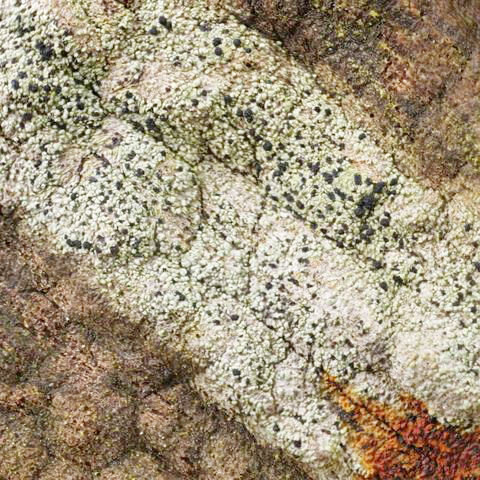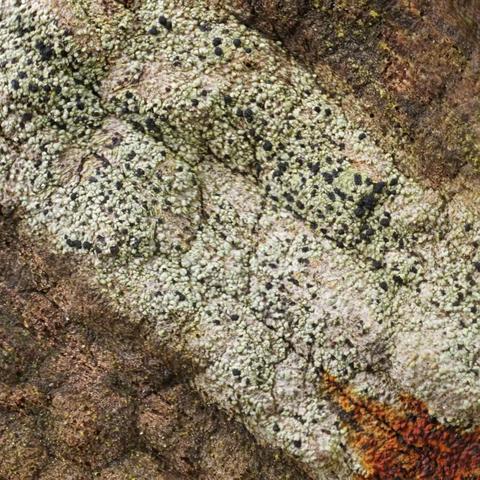Buellia hyperbolica Bagl.
N. Giorn. Bot. Ital., 3: 266, 1871.
Synonyms:
Distribution: N - Lig (Putortì & al. 1999b, Giordani & al. 2025). C - Tosc (Putortì & al. 1999, Giralt & al. 2000), Sar (Rizzi & al. 2011, Di Nuzzo & al. 2022).
Description: Thallus crustose, episubstratic, whitish, whitish grey or yellowish green, continuous, granulose or rimose, usually forming wide patches. Apothecia lecideine-biatorine, black, 0.2-0.4 mm across, adnate, sometimes confluent, with a flat to strongly convex disc, and a thin, often finally excluded proper margin. Proper exciple poorly developed, to 20 μm thick, K+ pale yellow; epithecium dark brown; hymenium colourless, without oil droplets, 70-90(-100) μm high; apical cells of paraphyses swollen, (3.5-)4-5 μm wide; hypothecium inspersed with oil droplets, 100-120 μm high, K+ yellow. Asci 8-spored, clavate to cylindrical-clavate, the apical dome K/I+ dark blue with a pale, conical-pointed apical cushion (axial mass), the wall I-, but the thin outer gel I+ blue, Bacidia-type. Ascospores 1-septate, brown, ellipsoid, (19-)21-24(-29) x 7.5-9.5(-11) μm, thickened at septum when young, uniformly thin-walled at maturity, finely ornamented. Photobiont chlorococcoid. Spot tests: thallus K+ yellow-brown, C-, KC-, P+ orange-red, UV-. Chemistry: with variable, usually low amounts of atranorin, fumarprotocetraric, protocetraric, confumarprotocetraric and convirensic acids.Note: a species with a mainly western distribution in Europe, found on trunks of old trees, especially Castanea and Quercus, and on lignum. From Tuscany, besides the type, there are recent collections from the province of Lucca, on Castanea, by Coppins (in litt.). It is included in the Italian red list of epiphytic lichens as “Endangered” (Nascimbene & al. 2013c).
Growth form: Crustose
Substrata: bark and lignum
Photobiont: green algae other than Trentepohlia
Reproductive strategy: mainly sexual
Poorly known taxon in need of further study
Commonnes-rarity: (info)
Alpine belt: absent
Subalpine belt: absent
Oromediterranean belt: absent
Montane belt: extremely rare
Submediterranean belt: absent
Padanian area: absent
Humid submediterranean belt: very rare
Humid mediterranean belt: absent
Dry mediterranean belt: absent

Predictive model
Herbarium samples
Growth form: Crustose
Substrata: bark and lignum
Photobiont: green algae other than Trentepohlia
Reproductive strategy: mainly sexual
Poorly known taxon in need of further study
Commonnes-rarity: (info)
Alpine belt: absent
Subalpine belt: absent
Oromediterranean belt: absent
Montane belt: extremely rare
Submediterranean belt: absent
Padanian area: absent
Humid submediterranean belt: very rare
Humid mediterranean belt: absent
Dry mediterranean belt: absent

Predictive model
| Herbarium samples |
 INDEX FUNGORUM
INDEX FUNGORUM
 GBIF
GBIF



